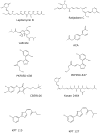Nuclear export of proteins and drug resistance in cancer
- PMID: 22209898
- PMCID: PMC4521586
- DOI: 10.1016/j.bcp.2011.12.016
Nuclear export of proteins and drug resistance in cancer
Abstract
The intracellular location of a protein is crucial to its normal functioning in a cell. Cancer cells utilize the normal processes of nuclear-cytoplasmic transport through the nuclear pore complex of a cell to effectively evade anti-neoplastic mechanisms. CRM1-mediated export is increased in various cancers. Proteins that are exported in cancer include tumor-suppressive proteins such as retinoblastoma, APC, p53, BRAC1, FOXO proteins, INI1/hSNF5, galectin-3, Bok, nucleophosmin, RASSF2, Merlin, p21(CIP), p27(KIP1), N-WASP/FAK, estradiol receptor and Tob, drug targets topoisomerase I and IIα and BCR-ABL, and the molecular chaperone protein Hsp90. Here, we review in detail the current processes and known structures involved in the export of a protein through the nuclear pore complex. We also discuss the export receptor molecule CRM1 and its binding to the leucine-rich nuclear export signal of the cargo protein and the formation of a nuclear export trimer with RanGTP. The therapeutic potential of various CRM1 inhibitors will be addressed, including leptomycin B, ratjadone, KOS-2464, and specific small molecule inhibitors of CRM1, N-azolylacrylate analogs, FOXO export inhibitors, valtrate, acetoxychavicol acetate, CBS9106, and SINE inhibitors. We will also discuss examples of how drug resistance may be reversed by targeting the exported proteins topoisomerase IIα, BCR-ABL, and galectin-3. As effective and less toxic CRM1 export inhibitors become available, they may be used as both single agents and in combination with current chemotherapeutic drugs. We believe that the future development of low-toxicity, small-molecule CRM1 inhibitors may provide a new approach to treating cancer.
Copyright © 2011 Elsevier Inc. All rights reserved.
Figures


Similar articles
-
Inhibition of CRM1-dependent nuclear export sensitizes malignant cells to cytotoxic and targeted agents.Semin Cancer Biol. 2014 Aug;27:62-73. doi: 10.1016/j.semcancer.2014.03.001. Epub 2014 Mar 12. Semin Cancer Biol. 2014. PMID: 24631834 Free PMC article. Review.
-
Nucleo-cytoplasmic transport as a therapeutic target of cancer.J Hematol Oncol. 2014 Dec 5;7:85. doi: 10.1186/s13045-014-0085-1. J Hematol Oncol. 2014. PMID: 25476752 Free PMC article. Review.
-
Human multiple myeloma cells are sensitized to topoisomerase II inhibitors by CRM1 inhibition.Cancer Res. 2009 Sep 1;69(17):6899-905. doi: 10.1158/0008-5472.CAN-09-0484. Epub 2009 Aug 18. Cancer Res. 2009. PMID: 19690141 Free PMC article.
-
CRM1-mediated nuclear export of proteins and drug resistance in cancer.Curr Med Chem. 2008;15(26):2648-55. doi: 10.2174/092986708786242859. Curr Med Chem. 2008. PMID: 18991627 Review.
-
CBS9106 is a novel reversible oral CRM1 inhibitor with CRM1 degrading activity.Blood. 2011 Oct 6;118(14):3922-31. doi: 10.1182/blood-2011-01-333138. Epub 2011 Aug 12. Blood. 2011. PMID: 21841164
Cited by
-
Potential biofluid markers and treatment targets for renal cell carcinoma.Nat Rev Urol. 2013 Jun;10(6):336-44. doi: 10.1038/nrurol.2013.52. Epub 2013 Apr 2. Nat Rev Urol. 2013. PMID: 23545813 Review.
-
Sequential Administration of XPO1 and ATR Inhibitors Enhances Therapeutic Response in TP53-mutated Colorectal Cancer.Gastroenterology. 2021 Jul;161(1):196-210. doi: 10.1053/j.gastro.2021.03.022. Epub 2021 Mar 19. Gastroenterology. 2021. PMID: 33745946 Free PMC article.
-
Potential effects of CRM1 inhibition in mantle cell lymphoma.Chin J Cancer Res. 2012 Dec;24(4):374-87. doi: 10.3978/j.issn.1000-9604.2012.09.05. Chin J Cancer Res. 2012. PMID: 23357869 Free PMC article.
-
XPO1 inhibitor combination therapy with bortezomib or carfilzomib induces nuclear localization of IκBα and overcomes acquired proteasome inhibitor resistance in human multiple myeloma.Oncotarget. 2016 Nov 29;7(48):78896-78909. doi: 10.18632/oncotarget.12969. Oncotarget. 2016. PMID: 27806331 Free PMC article.
-
KPT-8602, a second-generation inhibitor of XPO1-mediated nuclear export, is well tolerated and highly active against AML blasts and leukemia-initiating cells.Leukemia. 2017 Jan;31(1):143-150. doi: 10.1038/leu.2016.145. Epub 2016 May 23. Leukemia. 2017. PMID: 27211268 Free PMC article.
References
-
- Longley DB, Johnston PG. Molecular mechanisms of drug resistance. J Pathol. 2005;205:275–92. - PubMed
-
- Gottesman MM. Mechanisms of cancer drug resistance. Annu Rev Med. 2002;53:615–27. - PubMed
-
- Ishikawa T, Ali-Osman F. Glutathione-associated cis-diamminedichloropla-tinum(II) metabolism and ATP-dependent efflux from leukemia cells. Molecular characterization of glutathione-platinum complex and its biological significance. J Biol Chem. 1993;268:20116–25. - PubMed
-
- Fink D, Aebi S, Howell SB. The role of DNA mismatch repair in drug resistance. Clin Cancer Res. 1998;4:1–6. - PubMed
Publication types
MeSH terms
Substances
Grants and funding
LinkOut - more resources
Full Text Sources
Other Literature Sources
Medical
Research Materials
Miscellaneous

